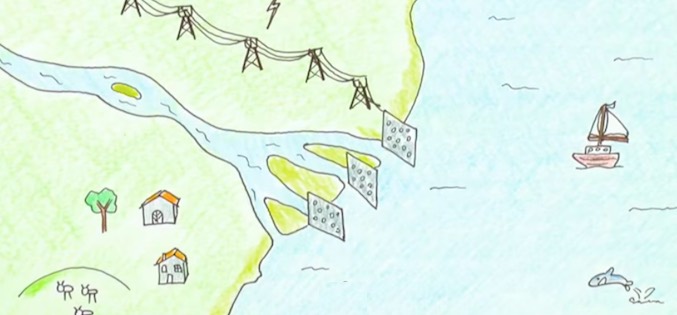Electricity From Salt Water: A New Abundant Clean Energy Source From Rivers
Anthony Cuthbertson
River mouths around the world may soon provide an abundant new source of clean energy after scientists developed an efficient system to generate electricity from salt water.
Research published this week in the journal Nature outlines how significant amounts of power can be generated from a natural phenomenon that occurs when fresh water comes into contact with seawater through a membrane.
The process of osmosis that occurs can be harnessed to capture the electrical charge of the salt ions that travel through the membrane to balance the concentrations in each liquid.
“We had to first fabricate and then investigate the optimal size of the nanopore,” said Jiandong Feng, a researcher at EPFL’s Laboratory of Nanoscale Biology and lead author of the research.
“If it’s too big, negative ions can pass through and the resulting voltage would be too low. If it’s too small, not enough ions can pass through and the current would be too weak.”
Osmosis is seen as a promising source of renewable energy, with the potential for technology deployed in river estuaries where fresh water from rivers meets the salt water of the sea. Unlike solar panels that require adequate sunlight, or wind turbines that require adequate wind, osmotic energy can be produced any time of day or night.
Pilot projects of harnessing osmotic power have taken place in Europe, Japan and the U.S., using fragile membranes that deliver low yields of electricity.
The potential of the new system is huge, with the researchers calculating that a 1m² membrane would be able to produce enough electricity to power 50,000 standard energy-saving light bulbs.
Before this technology can be scaled up in this way, however, scientists need to find a way to make relatively uniform pores.
River mouths around the world may soon provide an abundant new source of clean energy after scientists developed an efficient system to generate electricity from salt water.
Research published this week in the journal Nature outlines how significant amounts of power can be generated from a natural phenomenon that occurs when fresh water comes into contact with seawater through a membrane.
The process of osmosis that occurs can be harnessed to capture the electrical charge of the salt ions that travel through the membrane to balance the concentrations in each liquid.
“We had to first fabricate and then investigate the optimal size of the nanopore,” said Jiandong Feng, a researcher at EPFL’s Laboratory of Nanoscale Biology and lead author of the research.
“If it’s too big, negative ions can pass through and the resulting voltage would be too low. If it’s too small, not enough ions can pass through and the current would be too weak.”
Osmosis is seen as a promising source of renewable energy, with the potential for technology deployed in river estuaries where fresh water from rivers meets the salt water of the sea. Unlike solar panels that require adequate sunlight, or wind turbines that require adequate wind, osmotic energy can be produced any time of day or night.
Pilot projects of harnessing osmotic power have taken place in Europe, Japan and the U.S., using fragile membranes that deliver low yields of electricity.
The potential of the new system is huge, with the researchers calculating that a 1m² membrane would be able to produce enough electricity to power 50,000 standard energy-saving light bulbs.
Before this technology can be scaled up in this way, however, scientists need to find a way to make relatively uniform pores.
